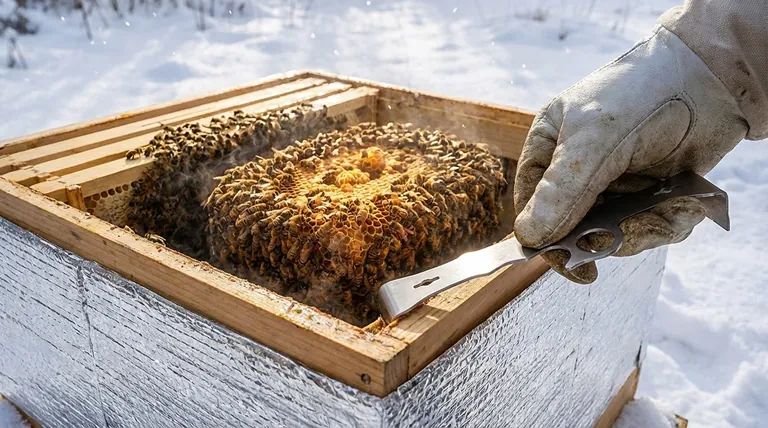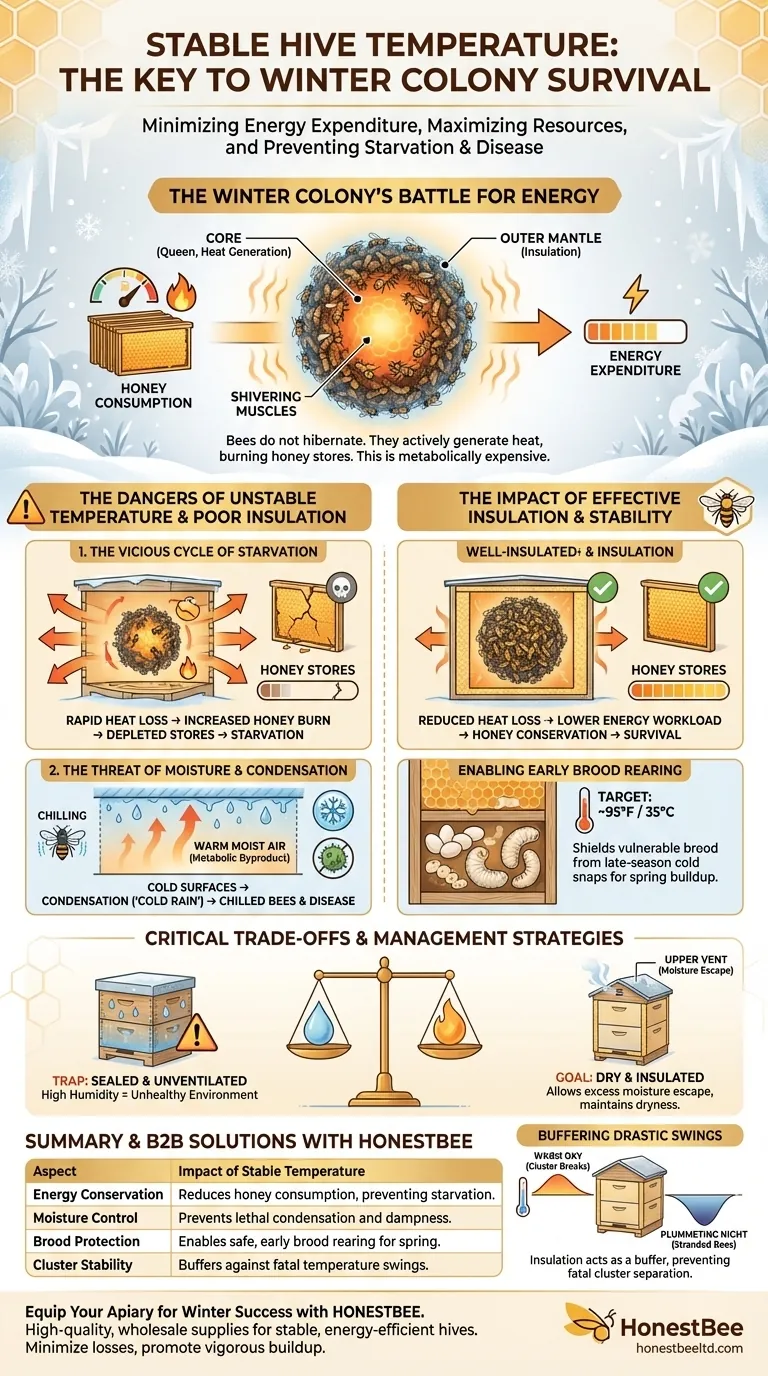To put it simply, a stable hive temperature is the difference between survival and starvation for a honeybee colony in winter. It's not about keeping the bees cozy, but about creating an energy-efficient environment that minimizes their workload and protects them from the twin threats of moisture and metabolic exhaustion.
A stable hive temperature creates an efficient system that drastically reduces the energy bees must expend to stay alive. This conservation of resources directly minimizes the two primary causes of winter colony loss: starvation and moisture-related disease.

Why a Stable Temperature is Non-Negotiable
A honeybee colony does not hibernate. Instead, it enters a state of active, collective survival centered entirely on temperature management.
The Physics of the Winter Cluster
Bees survive the cold by forming a tight ball, known as the winter cluster.
The bees on the outer layer of this cluster act as a living blanket, insulating the bees in the core.
The bees inside the core generate heat by shivering their powerful flight muscles. This constant vibration produces the thermal energy needed to keep the center of the cluster—and the vital queen—at a survivable temperature.
The Metabolic Cost of Heat Production
This heat generation is incredibly expensive. The bees are burning through their winter food source—honey—to fuel their "shivering."
In a poorly insulated hive, this precious heat is lost to the environment almost as quickly as it's created.
This forces the colony into a vicious cycle: burn more honey to generate more heat, which is then lost again. This rapidly depletes their food stores and is a direct path to starvation.
The Danger of Condensation
A byproduct of the bees' metabolism is water vapor. In a cold hive, this warm, moist air rises and hits the cold inner surfaces of the hive, where it condenses into water droplets.
This cold "rain" can drip back down onto the cluster, chilling the bees, causing stress, and creating a damp environment perfect for disease. A stable, well-insulated hive keeps the interior surfaces warmer, preventing this lethal condensation.
The Impact of Insulation
Insulation is the primary tool for stabilizing hive temperature. Its role is to break the cycle of heat loss and high energy consumption.
Reducing the Colony's Workload
By slowing the rate at which heat escapes, insulation allows the colony to maintain its target temperature with far less effort.
This dramatic reduction in energy expenditure means the bees consume significantly less honey, drastically lowering the risk of starvation before spring arrives.
Enabling Early Brood Rearing
In late winter, the queen will begin laying a small number of eggs to build the workforce for spring. This developing brood must be kept at a constant, high temperature (around 95°F / 35°C).
A stable, insulated hive provides a protected environment, shielding this vulnerable brood from sudden, late-season cold snaps that would otherwise kill it and set the colony back weeks.
Understanding the Trade-offs
While crucial, temperature management is not simply about sealing the hive as tightly as possible. A lack of understanding here can create new problems.
Insulation Without Ventilation is a Trap
A perfectly sealed but unventilated hive will trap moisture. Even if condensation doesn't form, the high humidity creates an unhealthy environment.
The goal is a dry and insulated hive, not a sealed plastic bag. Proper management includes a small upper entrance or vent to allow excess water vapor to escape.
The Risk of Drastic Temperature Swings
Wild temperature swings are a major threat. A warm day can cause the cluster to break apart and move, but if the temperature plummets overnight, bees can get stranded away from the cluster and their food, quickly freezing to death.
A well-insulated hive acts as a buffer, moderating the impact of these external swings and keeping the internal environment more predictable for the colony.
Making the Right Choice for Your Colony
Your strategy should be tailored to your specific goals and climate.
- If your primary focus is maximum winter survival: Prioritize a combination of insulation and a dedicated upper vent to create a dry, energy-efficient system that conserves honey stores.
- If your primary focus is a rapid spring build-up: Ensure your insulation strategy robustly protects the brood nest area from late cold snaps, securing the queen's first rounds of egg-laying.
- If your primary focus is managing a volatile climate: Use insulation as a buffer to moderate extreme temperature swings, preventing the cluster from making fatal mistakes.
Ultimately, managing winter hive temperature is about helping your bees win their long, arduous battle of energy conservation.
Summary Table:
| Aspect | Impact of Stable Temperature |
|---|---|
| Energy Conservation | Reduces honey consumption, preventing starvation. |
| Moisture Control | Prevents lethal condensation and dampness. |
| Brood Protection | Enables safe, early brood rearing for spring. |
| Cluster Stability | Buffers against fatal temperature swings. |
Equip Your Apiary for Winter Success with HONESTBEE
Your colonies' survival depends on the right equipment. At HONESTBEE, we supply commercial apiaries and beekeeping equipment distributors with the high-quality, wholesale-focused supplies needed to create stable, energy-efficient hives.
From advanced insulation solutions to durable hive components designed for optimal temperature management, our products help minimize winter losses and promote vigorous spring buildup.
Ensure your bees have the protection they need. Contact our wholesale experts today to discuss your apiary's requirements.
Visual Guide

Related Products
- HONESTBEE Advanced Ergonomic Stainless Steel Hive Tool for Beekeeping
- Professional Galvanized Hive Strap with Secure Locking Buckle for Beekeeping
- Professional Engraved Round Hive Number Tags for Beekeeping
- Langstroth Screen Bottom Board for Beekeeping Wholesale
- Heavy-Duty Galvanized Steel W-Style Pallet Clip
People Also Ask
- What are the features of a regular hive tool? The Essential Multi-Tool for Every Beekeeper
- What are some common uses of a hive tool? Essential Multi-Purpose Tool for Every Beekeeper
- What are the basic tools for beekeeping? Essential Starter Kit for Safe & Successful Hive Management
- How should beekeepers handle bees when using a hive tool? Master Calm, Deliberate Techniques
- What is a hive tool and what are its uses? Master Your Hive Inspections with the Essential Beekeeper's Tool



















